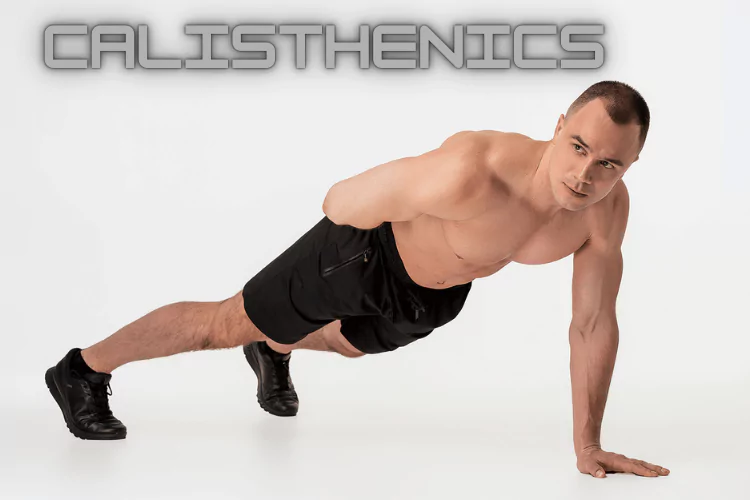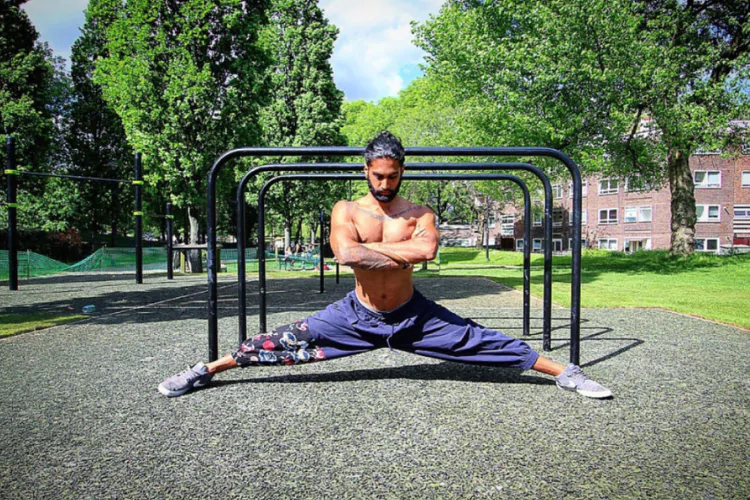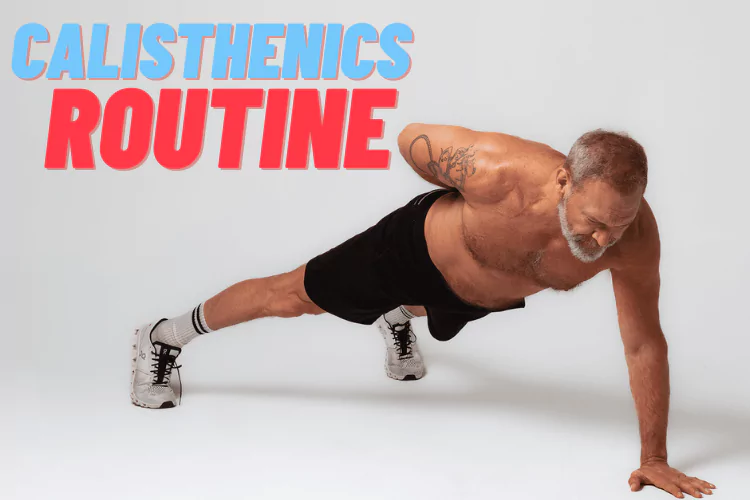Hello people! Want to have fun and build strength, flexibility, and power? Try calisthenics!
If you are interested in the subject of building up your total fitness, then nothing can beat bodyweight training or, to be more specific, calisthenics. Regardless of whether or not a person considers themselves highly physical or just beginning their journey, calisthenics should be highly regarded because it is an excellent way to build strength, flexibility, and power in a viable and long-term fashion.
In this article, you will learn about the aspects of fitness calisthenics trains, the scientific background behind it, the advantages of the calisthenics workout, and how to create a balanced calisthenics workout schedule.
Let’s dive in!
Table of Contents
What is Calisthenics?

Otherwise known as fitness exercise, calisthenics is a form of exercise that aims to strengthen body weight while improving flexibility, stamina, and balance. The greatest appeal of calisthenics is the joy of not using equipment, and any exercise can be done at any location. Push-ups, pull-ups, squats, lunges, and planks form the basis of most Calisthenic exercises, although there are many more.
Recent trends have seen calisthenics favored since it enables a person to build up their fitness level as they exercise each of the muscles in a way that they are familiar with in their everyday activities. This makes calisthenics training a highly effective way to build total fitness: coordination of strength, flexibility, and power.
Calisthenics for Strength
When people set their minds towards developing strength, most of them will begin by lifting iron in their gym. But in the same respect, calisthenics training can be as appealing, if not more appealing, than conventional weight training focusing on functional strength. In fact, bodyweight exercise works for various muscle groups at once, hence making significant differences in terms of qualities such as endurance, strength, and coordination.
How Does Calisthenics Build Strength
Many exercises, such as push-ups, pull-ups, squats, dips, and planks, are calisthenics that build up the big muscles of the upper puncheon and lower part of the body. These compound movements lead the muscles to contract and work together, thus enhancing the functional strength you gain as a Crossfitter.
- Upper Body Strength: Assisted and unassisted push-ups and pull-ups are among the best workouts for building chest, shoulder, and arm muscles. Pull-ups involve the back and bis, while push-ups involve the chest, shoulder, and triceps.
- Lower Body Strength: Another advantage of calisthenics is lower body strength. The workout includes squat and lunge activities and single-leg movements. Some of these exercises assist in building the quadriceps, hamstring, gluteal, and calf muscles while improving balance and coordination.
Moreover, calisthenics exercises can be normalized or manipulated. First of all, improving the basic body mass may complicate the effectiveness by changing the number of reps, increasing the amount of time under tension, or performing one-arm push-ups or pistol squats.
Calisthenics for Flexibility

Another key element of fitness that is frequently ignored when people go for a straight-strength workout is flexibility. The calisthenics’ emphasis on strength and the incorporation of flexibility training significantly prevent possible injuries and enhance mobility and overall functioning movements throughout the lifespan.
Why Flexibility Matters
Flexibility is, therefore, joint and muscle mobility, and it is wide because of corrective functioning in good posture and mechanical motion. Without it, even the biggest muscles in your body cannot work efficiently. Stretchable muscles mean that you enjoy wider freedom of movement, which in turn enhances the efficiency of movements you make during the activity so as to avoid straining muscles during workouts.
- Dynamic Stretching: This argument is particularly interested in the fact that flexibility is developed in calisthenics through dynamic exercises such as leg swing, arm circle, and torso twist. These movements involve the use of muscles and joints in dynamic activities that may increase the mobility and flexibility of the muscles and joints used in performing these movements in the long run.
- Static Stretching: To sum up, after the calisthenics workout, one performs static stretching similar to a hamstring stretch, hip flexor stretch, or chest stretch. Static stretching increases muscle flexibility and allows muscles to relax after exercise.
Studies have noted improvement in flexibility training, which decreases muscle soreness, increases performance, and averts injuries. In a study published in the British Journal of Sports Medicine, stretching exercises can increase by about 10-15 % after some weeks of practice.
Calisthenics for Power
Explosiveness is the swift generation of power, which is applicable in explosive exercise, sports or games, and all sorts of physical strength. One of the strongest aspects of calisthenics, therefore, is that many of the exercises are very powerful because they involve certain elements of dynamics and explosive power, which recruits the two-bag muscle fibers.
Explosive power part 2 – calisthenics
Movements such as jump squats, burpees, box jumps, and clapping push-ups trigger a rapid type of contraction through their fast-twitch fibers. These exercises build strength, speed, agility, and power.
Jump Squats assist in developing lower body power in powerful evasive moves that work every muscle group in the quads, hamstrings, glutes, and calves in an explosive upward motion. This exercise imitates the act of jumping and is excellent as a speed, agility, and strength-builder.
- Clapping Push-ups: This is a modification of the ordinary push-up. In this type, you push the ground with enough force to flip both hands and clap. It helps tone and develop the upper body muscles, particularly the chest, shoulder, and triceps.
- Burpees: These effective exercises combine strength, power, and endurance in the same episode as body contact exercises. They activate nearly all of the body’s muscle groups and can build strength and explosive power.
A scientific study conducted in 2020 and published in the Journal of Strength & Conditioning Research found that plyometric movements (which include jump squats and burpees) increase muscle power and explosiveness in calisthenics, making them efficient for boosting athletic performance.
Calisthenics Advantage for Total Fitness
But first, it is important to distinguish between strength, flexibility, and power—all these terms are very significant as far as total fitness is concerned. Calisthenics is in the absolute sweet spot in all three aspects and, hence, the best exercise regime.
Why is Calisthenics Ideal for Total Fitness
- Versatility: There is no equipment, no fancy gizmos; all you have is your body weight, and that should be enough. While athletic exercises can be done at home and in a park, calisthenics exercises are mostly done at any time of the day, even in the morning, evening, or night.
- Scalability: In general execution, different exercises may be made complex or modified to suit the learner’s level; thus, calisthenics training may be interesting to different levels of trainers. The key here is that in order to scale the difficulty up and down, you can change the number of repetitions or sets and/or even the type of exercise being done.
Here are some tips to help you get started:
- Master the Basics: To start, get through ten push-ups, ten squats, ten lunges, and any plank movement. This reduces the possibility of an individual acquiring some injuries and enhances aliveness.
Getting Started with Calisthenics:
To those who are really courting calisthenics and would desire to get into the performance, it is advisable to take some time to build the intensity of the workout and their stamina. Here are some tips to help you get started:
- Master the Basics: To start, get through ten push-ups, ten squats, ten lunges, and any plank movement. Develop a good form for your lifts before you move on to the next level with the various movements.
- Warm Up and Stretch: Wuha! Warm up by doing some exercises that initiate your muscles and joints during the exercise. When you are doing your post-workout, you will add static stretching to enhance flexibility and reduce musculoskeletal stiffness.
- Consistency is Key: Like in any fitness regime, repetition is key here, too. Once people start practicing in the gym, they find that the exercises become easier despite being tougher only in terms of flexibility, power, etc.
- Progressive Overload: As the weeks go by, more intensity needs to be added to the exercises to ensure that the results begin to improve. According to this principle, this may involve increasing the number of repetitions, extending the amplitude, or switching to higher levels of development.
- Listen to Your Body: Notice any signs of aching or soreness. Some workouts can be done in a day or two of breaks. One important thing to understand about calisthenics is that it’s not about maximum, single-session effort.
The following video explains about Calisthenics Advantage for Total Fitness:
Conclusion
So, calisthenics is a genuine and efficient method for becoming stronger, more flexible, and more powerful. With body, you can target all body muscle groups, improve flexibility, and increase explosiveness. The beauty of calisthenics is that it is scalable, accessible, and functional, meaning training will transfer lifelike movement.
Whether the goal entails becoming a sports athlete, weight loss, or creating a healthy body with the ability to equal both strength and flexibility, calisthenics has all the answers. Adding these exercises to your fitness plan will ensure you are on this path to attaining total fitness and, thus, actualization.
Are you all set to gain strength, flexibility, and power? Start calisthenics today!
FAQ
1. What role does calisthenics play in supporting total fitness?
Calisthenics builds up muscle strength and flexibility, thus increasing power, which results in increased fitness.
2. Does calisthenics take as much muscle as weight training?
Of course, bodyweight exercises do incorporate several muscles for functional strength.
3. How often should one take calisthenics exercises for greatest effectiveness?
In order to see progress, it would help if you did it ideally at least 3-5 times a week.
4. Can calisthenics be done by beginners?
Of course, we can perform calisthenics for individuals of all fitness levels.
5. Does calisthenics help in flexibility as much as yoga?
Indeed, dynamic stretches included in calisthenics contribute to the flexibility and movement capacity of participants.




